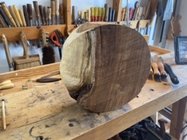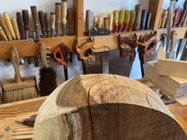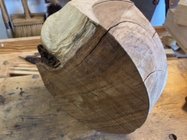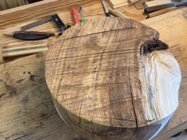-
We just finished moving the forums to a new hosting server. It looks like everything is functioning correctly but if you find a problem please report it in the Forum Technical Support Forum (click here) or email us at forum_moderator AT aawforum.org. Thanks! -
Beware of Counterfeit Woodturning Tools (click here for details) -
Johnathan Silwones is starting a new AAW chapter, Southern Alleghenies Woodturners, in Johnstown, PA. (click here for details) -
Congratulations to Dave Roberts for "2 Hats" being selected as Turning of the Week for April 22, 2024 (click here for details) -
Welcome new registering member. Your username must be your real First and Last name (for example: John Doe). "Screen names" and "handles" are not allowed and your registration will be deleted if you don't use your real name. Also, do not use all caps nor all lower case.
You are using an out of date browser. It may not display this or other websites correctly.
You should upgrade or use an alternative browser.
You should upgrade or use an alternative browser.
Is this a safe bowl blank?
- Thread starter Richard Moore
- Start date
IMHO, that's an accident waiting to happen. I saw those to firewood size and put on firewood pile. I tried one of those early on in my hobby, and as expected, it did not make it to final product and did indeed go to pieces even with my taking very thin cuts. Never again, for me anywayz. Way too much wood out there to invite hurting yourself. again, IMHO.
I am with John . Looks like ring shake and will not stay together. What you can do is rip out the crack and use that beautiful wood as spindle blanks.
- Joined
- Apr 27, 2004
- Messages
- 8,641
- Likes
- 4,982
- Location
- Lakeland, Florida
- Website
- www.hockenberywoodturning.com
gut tells me I should break it down into smaller blanks.
Go with your gut on this one.
You might be able to turn the outside of the bowl but maybe not.
Once you hollow a great likelihood that the section between the two cracks will break away.
Could be a ring shake with no structural integrity.
With wire and tape you might keep it together for hollowing but then you have a bowl with two big cracks in it.
No upside to the risk in turning it safely or the possible end reward if you succeed.
Last edited:
- Joined
- Apr 27, 2004
- Messages
- 8,641
- Likes
- 4,982
- Location
- Lakeland, Florida
- Website
- www.hockenberywoodturning.com
But I’m curious would a more experienced turner take this chance?
One thing I do with ring shakes
Use them to turn hollow balls. The glue line along the ring shake is nearly invisible.
I cut the blank so the ring shake is in the middle and I’m satisfied the tailstock pressure will hold the two pieces together to rough turn the ball with tenons on each end. Each half is hollowed like a small bowl.
Glue the two half’s together with tight bond - can use the lathe to hold it overnight.
Turn the ball the next day.
I often glue a quarter inside so non woodturners know it is hollow by the rattle.
Woodturners always know by the weight.
- Joined
- Jan 27, 2005
- Messages
- 12,898
- Likes
- 5,188
- Location
- Dalworthington Gardens, TX
- Website
- pbase.com
Life is too short to turn crappy wood.
Fire wood to me. Maybe salvage some spindle blanks out of the middle. I would split it on the ring shake cracks that are already in it. Some people take great delight in taking the worst possible pieces of wood and turning some thing out of them. Me, I don't care for all the extra work you have to do just to be able to salvage a piece like that. Some of the epoxy resins may be able to fill in those cracks, and make the piece sound again, but I don't know.... never done that one before. May try it some time....
robo hippy
robo hippy
Thank you gentlemen. I felt my gut feeling was the correct and I will break this blank down and see what can be salvaged.
The gentleman who sent this to me is in Hawaii and it may not have been like this when he shipped it. Either way I have nothing invested in this piece.
My work space is inside a bonus room above my garage and fixing Sheetrock and or going to the ER isn’t on the agenda.
rigging up something in hopes of it staying together is not in my wheelhouse. Several decades back I broke my hand turning a bowl on a lathe, that and any other injury’s is something I want to avoid. And yes I should have known better when I broke my hand but I was young and thought I was bulletproof.
The gentleman who sent this to me is in Hawaii and it may not have been like this when he shipped it. Either way I have nothing invested in this piece.
My work space is inside a bonus room above my garage and fixing Sheetrock and or going to the ER isn’t on the agenda.
rigging up something in hopes of it staying together is not in my wheelhouse. Several decades back I broke my hand turning a bowl on a lathe, that and any other injury’s is something I want to avoid. And yes I should have known better when I broke my hand but I was young and thought I was bulletproof.
You've still got 3 spindle blanks from some real interesting wood that made a long journey so you could make something out of it.
Life has enough challenges by itself without creating more, study the wood grain and cut it along the existing splits into spindle blanks.
IMO It does provide a learning opportunity. You know it is very suspect. Opportunity to do some “investigative turning” keeping yourself out of the line of fire, and see what you find/learn.
Also the opportunity to cut it up for something else.
Also the opportunity to cut it up for something else.
I see segments, not sure why, haha!!
To an experienced eye, those defects can usually be spotted right away. Some times the crack is highly visible, some times the ring shake will just have a darker color.
robo hippy
robo hippy
I think I see.I see segments, not sure why, haha!!
Like others said - not as a bowl blank. The wood will likely fly apart at multiple locations from the looks of the ring shake. Not worth it. I am going to make another post in a few minutes about staying out of the line of fire - my guess is my piece came from ring shake that I missed because of the waxed ends.
If the wood is very valuable (expensive, one of a kind or sentimental) then I drill across the cracks and glued in several dowels or skewers to stabilize the crack. Then fill the crack with CA glue and sanding dust (or coffee grounds) so my gouge is less likely to catch on the crack. This still requires wearing a face shield, turning at slower speeds and staying out of the of fire. Not something I‘d do if there’s any chance of ring shake since this is a sure fire way to have a big chunk break off.
What are the basic rules? Turn nothing with a crack? How can a newbie know? Haven’t seen anything in the books that tells me. Thanks.
Excellent reason to work with a mentor and/or your local turning club. Defects are pretty hard to describe clearly, and as far as I know, there isn't a picture book. Learning by having bad experiences can be painful or even dangerous.What are the basic rules? Turn nothing with a crack? How can a newbie know? Haven’t seen anything in the books that tells me. Thanks.
- Joined
- Feb 28, 2021
- Messages
- 1,226
- Likes
- 1,075
- Location
- Roulette, PA
- Website
- www.reallyruralwoodworks.com
Good rule of thumb when you are new - If you have to ask yourself "will this be safe to turn?" , you probably shouldn't try to turn it until you have some real practical experience under your belt ...What are the basic rules? Turn nothing with a crack? How can a newbie know? Haven’t seen anything in the books that tells me. Thanks.
When you can turn something without getting catches to a form you want (practice), and have mastered getting nice smooth finish cuts that need less sanding, you should feel comfortable enough to go back to that piece of wood, and take a close look at where the defect is going to be, and ask yourself "if I get a catch here, would the blank break away, split, and fly apart?" by then you may have learned to read the grain and have had time to get familiar with your lathe, the tooling, the techniques, and more, and on riskier pieces, you may have solutions in mind to make turning it safer (Glue on a solid ring on the top, that can be turned away when done, or glue in scraps to bridge gaps or voids, etc, etc)
But as Dean mentions, you're best off finding a mentor to help you get over that learning curve faster (I still think of myself as a relative newbie, after 2 years or so of being self-taught... no mentors or clubs within reasonable drive times for me, unfortunately , so I have to do everything the hard way)
I frequently have trouble seeing shake until I’m into the piece, but so far I’ve been able to set aside for some other purpose.To an experienced eye, those defects can usually be spotted right away. Some times the crack is highly visible, some times the ring shake will just have a darker color.
robo hippy
Unless you want to take the time to cut in some bowties as you get the outer shape of it, I'd cut it into smaller pieces.
Not a safe blank as it is, but at low RPM with some reinforcements (or some epoxy resin and pressure) it could be turned into a bowl.
Not a safe blank as it is, but at low RPM with some reinforcements (or some epoxy resin and pressure) it could be turned into a bowl.
- Joined
- Apr 27, 2004
- Messages
- 8,641
- Likes
- 4,982
- Location
- Lakeland, Florida
- Website
- www.hockenberywoodturning.com
i evaluate the safety and estimate how the crack will affect the finished pieces. Working with a mentor like @Dean Center recommended will boost your skill level and your ability to evaluate the crack.What are the basic rules? Turn nothing with a crack? How can a newbie know? Haven’t seen anything in the books that tells me. Thanks.
my rule: can I turn it without it coming apart and want to.. if the piece is liked to separate from the mounting point don’t turn it.
little end check cracks or cracks in a knot rarely pose a safety issue,
radial cracks, ring shakes, and bark inclusions often pose a serious safety risk and can often go much further than they appear to.
I occasionally turn hollow balls using a ring shake. this is a crack that follows a growth ring.
i shape the ball between centers With the ring shake close to the center of the ball and perpendicular to the ways.
I put a tenon on both ends. then hollow each part Like they were little bowls. They come apart at the ring shake often with out ant tugging. It’s safe for me to turn the two pieces of wood held together by tailstock pressure.
then glue the two parts together and finish turn the ball. A glue joint on the ring is nearly impossible to see.
here is an e check type crack I used in a hollow form. Totally safe to turn.

Last edited:
I would not turn it as is. I would cut it up and make some smaller lidded boxes and vases.




